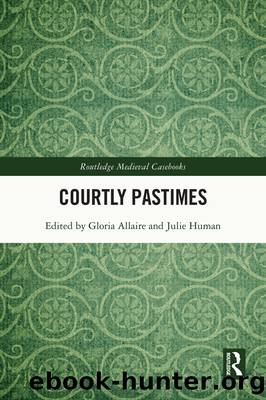Courtly Pastimes by Human Julie

Author:Human, Julie
Language: eng
Format: epub
Publisher: Taylor & Francis (Unlimited)
Published: 2022-10-12T00:00:00+00:00
These qualities of heart and mind and this manner of comportment, as his several dits suggest, are among those that identify a courtier. In addition, his devotion to the composition of poetry and music was to earn for him an enduring reputation as the greatest courtier-poet of his century.
Notes
Paule Demats, âD'Admoenitas à Deduit: André le Chapelain et Guillaume de Lorris,â in Mélanges de langue et de littérature du Moyen ge et de la Renaissance offerts à Jean Frappier, Publications romanes et français 112 (Geneva: Droz, 1970), 1:226â30.
Richard Firth Green, âThe Familia Regis and the Familia Cupidinis,â in English Court Culture in the Later Middle Ages, ed. V. J. Scattergood and J. W. Sherborne (New York, NY: St. Martin's Press, 1983), p. 91.
Guillaume de Machaut, Dit dou Vergier (Story of the Orchard), in âThe Fountain of Loveâ (La Fonteinne Amoureuse) and Two Other Love Vision Poems, ed. and trans. R. Barton Palmer, Garland Library of Medieval Literature 54, ser. A (New York, NY: Garland, 1993), line 126.
Dit dou Vergier, in âFountain of Love,â ed. and trans. Palmer, line 623.
Emma Cayley, âMachaut and Debate Poetry,â in A Companion to Guillaume de Machaut, ed. Deborah McGrady and Jennifer Bain, Brill's Companions to the Christian Tradition 33 (Leiden: Brill, 2012), p. 107.
Machaut, âLe Jugement du roy de Behaigneâ and âRemede de Fortune,â text ed. James I. Wimsatt and William W. Kibler, music ed. Rebecca A. Baltzer, Chaucer Library (Athens, GA: University of Georgia Press, 1988), p. 8.
Benjamin Albritton, âMoving across Media: Machaut's Lais and the Judgement Tradition,â in McGrady and Bain, Companion to Guillaume, p. 128.
Nigel Wilkins, âA Pattern of Patronage: Machaut, Froissart and the Houses of Luxembourg and Bohemia in the Fourteenth Century,â French Studies 37 (1983): 257â61.
Jacqueline Cerquiglini, âUn engin si soutilâ: Guillaume de Machaut et lâécriture au XIVe siècle, Bibliothèque du XVe siècle 47 (Paris: Honoré Champion, 1985), pp. 110â11.
Guillaume de Lorris and Jean de Meun, âLe roman de la Roseâ: Ãdition d'après les manuscrits BN 12786 et BN 378, ed. and trans. Armand Strubel, Le livre de poche 4533: Lettres gothiques (Paris: Le livre de poche, 1992), lines 103, 633. (All translations from the Rose are mine.)
See Machaut, âJugement,â ed. Wimsatt and Kibler, lines 2052â54. On this passage, see Laurence de Looze, ââMon nom trouverasâ: A New Look at the Anagrams of Guillaume de Machaut â The Enigmas, Responses, and Solutions,â Romanic Review 79 (1988): 545.
Lawrence Earp, âGenre in the Fourteenth-Century French Chanson: The Virelai and the Dance Song,â Musica Disciplina 45 (1991): 141.
Anne Hagopian van Buren, âReality and Literary Romance in the Park of Hesdin,â in Medieval Gardens, ed. Elisabeth Blair MacDougall (Washington, DC: Dumbarton Oaks Research Library and Collection, Trustees for Harvard University 1986), pp. 117, 123.
Machaut, âRemede de Fortune,â ed. Wimsatt and Kibler, lines 813â16.
Kevin Brownlee, Poetic Identity in Guillaume de Machaut (Madison, WI: University of Wisconsin Press, 1984), p. 38.
On the complexity of this âelusiveâ courtly form, see John Stevens, Words and Music in the Middle Ages: Song, Narrative, Dance and Drama, 1050â1350, Cambridge Studies in Music (Cambridge: Cambridge University Press, 1986), pp.
Download
This site does not store any files on its server. We only index and link to content provided by other sites. Please contact the content providers to delete copyright contents if any and email us, we'll remove relevant links or contents immediately.
Patriot by Alexei Navalny(337)
Museum of Antiquity by T. L. (Thomas Louis) Haines(275)
The Story of Joan of Arc by Andrew Lang(258)
The Memoirs of Pere Labat, 1693-1705 by Jean Baptiste(232)
The Apollo Moon Missions by Randy Walsh(232)
Richard III and the Princes in the Tower by A.J. Pollard(230)
2,2-Dimethyl-3,4-dihydro-2H-1,4-benzoxazines as isosteres of 2,2-dimethylchromans acting as inhibitors of insulin release and vascular smooth muscle relaxants by Bernard Pirotte & Xavier Florence & Eric Goffin & Philippe Lebrun(227)
Fry The Brain: The Art of Urban Sniping and its Role in Modern Guerrilla Warfare by John West(188)
A History of the Peninsular War, Vol. 5, Oct. 1811-Aug. 31, 1812 by Charles Oman(179)
The Memoirs of Count Grammont â Complete by Hamilton Anthony Count Walter Scott(177)
Life of Napoleon Bonaparte, Volume I. by Walter Scott(174)
1916 - The Battle of the Five Empires: 15 May - 28 September 1916 by Benoît Chenu(173)
Maleficium: Witchcraft and Witch Hunting in the West by Gordon Napier(170)
Rasputin the Rascal Monk by William Le Queux(161)
Famous Fights of Indian Native Regiments by Reginald Hodder(158)
BY MARK Twain, Twain - The innocents at home by 1881(147)
Father Browne's Titanic Album by E. E. O'Donnell(146)
The Thoughts of Marcus Aurelius by Marcus Aurelius(143)
Joanna of Flanders by Julie Sarpy(132)
